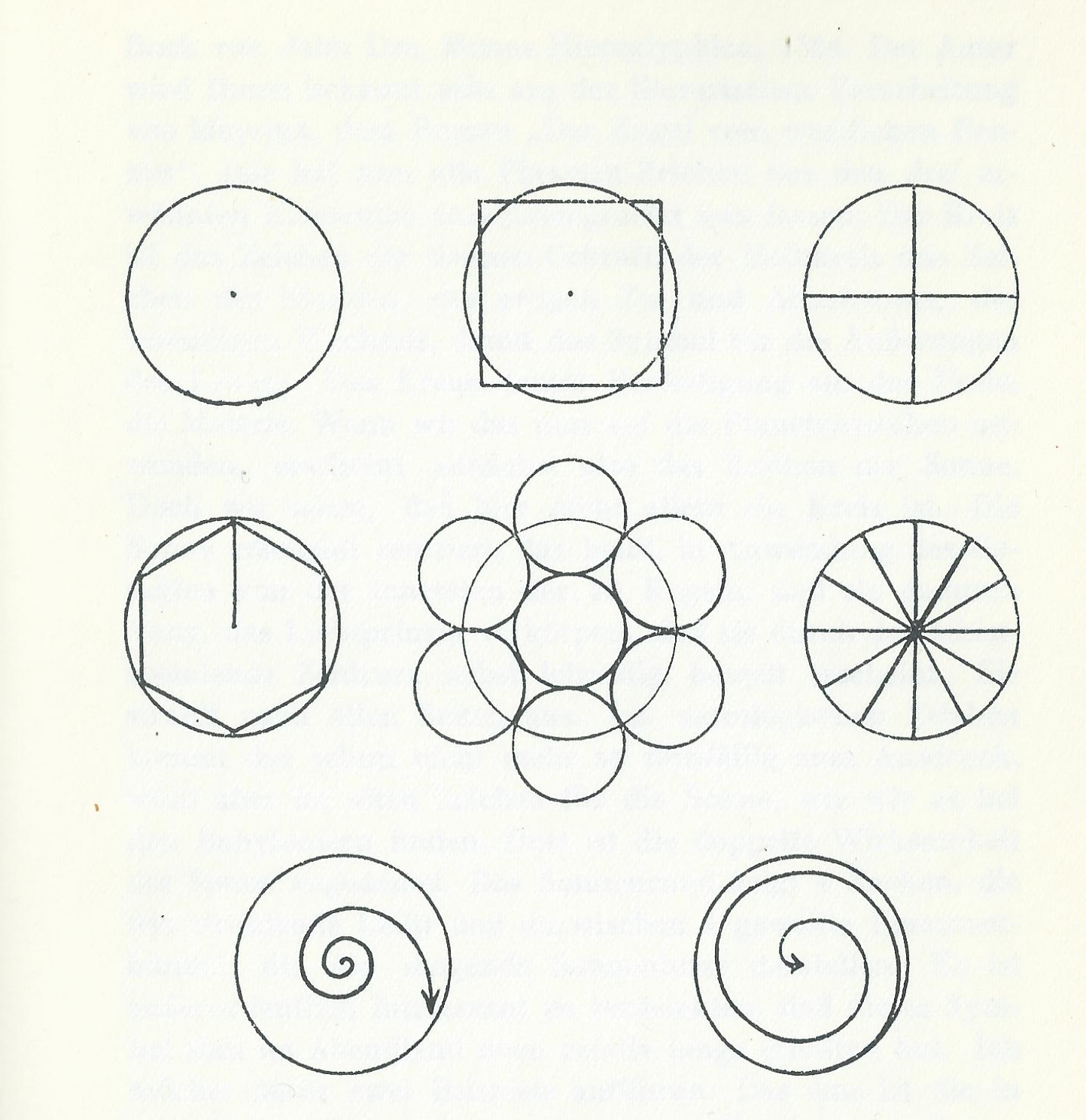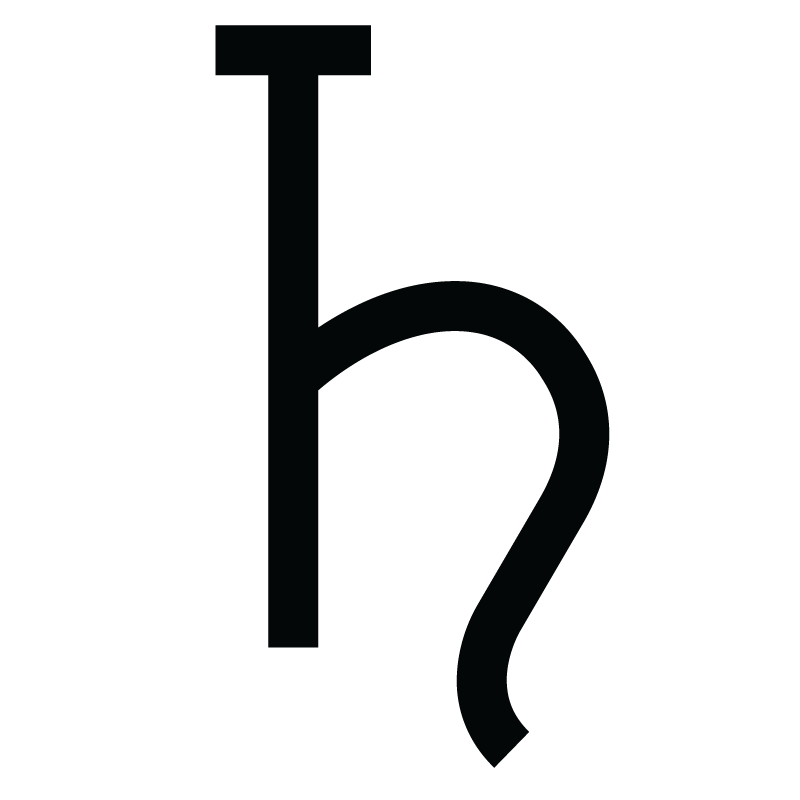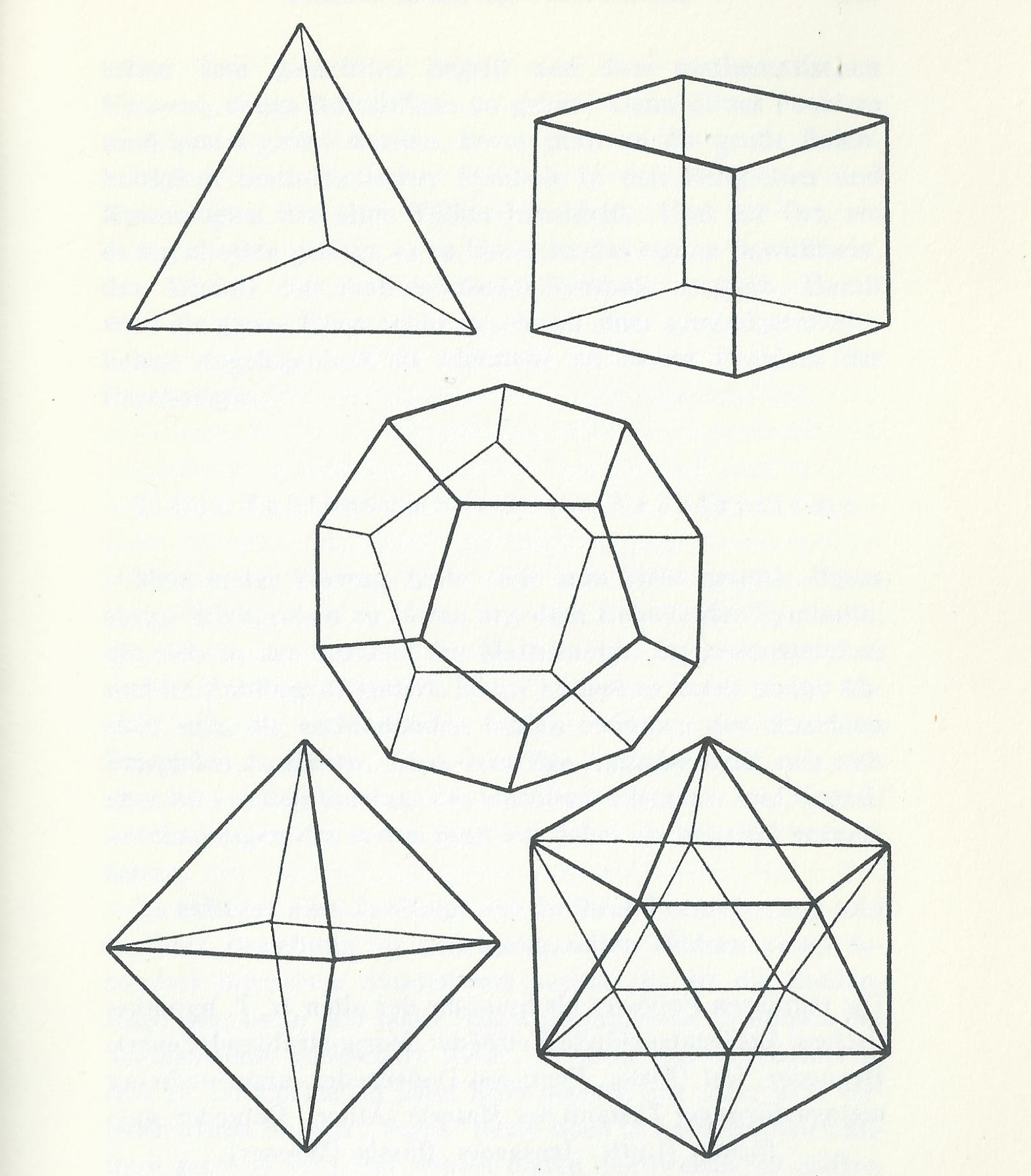General Remarks
by Rudolf Bernoulli
presented at the second Eranos Lectures in 1934
translated by Clark Kee
Above the entrance to the Greek temple of knowledge stands the quotation "Whoever has not mastered geometry may not enter here." Therewith is stated that geometry stands in a close relationship to concepts of knowledge and their study. To the study of knowledge in the sense as it here concerns research, then, driven with conscious thoughts, with keen awareness. But consciousness was always grounded in the depths of unconsciousness; one sees that best in that the idea that is indeed the beginning of every conscious thought comes from the unconscious and not the consciousness of the thought itself. The conscious search for a final basis of reality leads quickly into those depths in which the plumbline of words no longer reaches the bottom. Here there are only hints and parables. And here with its quantities, numbers, and figures geometry forms a language of symbols, which articulates a luminous analog to everything that is only vaguely perceptible regarding concepts in sharp thesis and antithesis, with precise boundaries, but in essence can no longer be grasped. It lies then in the realm of mathematics that figure and quantity point at something much deeper than clear concepts and graphic terms. We are so permeated by this point of view that we can't do without the mathematical images in contemporary language usage. So we speak, for example, of a starting point, of the range[lit. perimeter] of our thought; we make continuous use of data that we allow to run in and out of our possession like coins. Geometric figures, [and] the concept of number, have become everyday symbols to us. Wherever it has to do with characterizing something exactly, where the goal is to define something precisely, particularly when the concept goes beyond imagination, we take refuge in these symbols. Mathematics, otherwise signposts in space and time, in the measure and weight of quantities, shows yet another side, that of sharply delimited qualities. That is why the number, the geometric figure, can become a symbol.
Therefore I've chosen the theme because, for me, as far back as I'm able to remember, mathematical symbols were really an obsession. For me there's scarcely anything that can so completely become a meaningful symbol as a number or a geometrical figure. (You need not fear that I might be a particularly capable mathematician. Non-mathematicians, numerical-nonexperts will also be able to follow my presentation easily.) The idiosyncratic side of mathematical concepts, the living [aspect], the essence of the quality that is in every number, in every figure, was for me invariably an experience that certainly required a long time, until its formulation was to some extent possible. Maybe it is not yet finalized. But the matter pressed toward explosion. Such an occurrence happened not in organized observable circumstances, but has the benefit that the process somehow grips us. So allow me to demonstrate for you the explosion of my own experience of geometric and numeric symbols, in the danger that what I say will be familiar, or will run into contradictions.
Across from our own experience, another experience stands in parallel throughout: the collectivity experiences the number or the geometric figure in a similar way in that it becomes a symbol early on. Indeed in this early period the symbolic meaning of geometric representations and numbers having a symbolic emphasis is in most cases unknown to us. Only in later epochs does it grow light, literature arises, there are verifiable interpretations of numbers and figures. Most impressive among the Pythagoreans, from whose circle of ideas the Plato-inspired motto of our lecture is taken, very strongly also in Gnosticism and the Kabbala. But there is in general hardly any religious system in which number and geometric figures do not appear at all as carriers of important symbolic meaning. There are also gaps here, and I will from time to time allow myself to fill in individual gaps through my own experience with the danger that my subjective experience might stand in contradiction to hypotheses that were set up by someone else.
Which attributes must the geometric figures and numbers have in order to become a symbol? Next we establish that the way the number is written provides distinct information. In all number systems the numbers 1 to 3, sometimes even 1 to 4 are echoed by the corresponding number of simple lines. "Number grams" first appear with the number five, number signs that don't simply place one line next to or above another in this primitive way, but rather formulate the idea of the number indirectly via an image or a linguistic construct in a specific ideogram. In the Roman number five we have more-or-less a hand in stenographically abbreviated form, whose middle three fingers were left out (V); the ten is the doubling of the same (X). In Chinese-Japanese we have ten in the form of a cross standing upright and so on. We see, then, how the concept of number is at first grasped very simply, and only later, as many numbers appear, the polymorphism of number signs makes an appearance, at first as multiplication of the familiar (in Chinese for example the number 2 is placed above the cross that is ten, which then means 20), then the mark for many, C in the Roman system the abbreviation of "centum," hundred, the number concept that in the Chinese-Japanese system in addition to the exact sum 100 also means a very large, incalculable quantity.
The number reveals already what a symbol can be, what symbolic value it carries is initially always what is simple. The complicated numeric ideas arrive only in later times. Indeed it appears that such multiplied numbers that are constructed from the fundamental simple symbolically meaningful numbers acquire a symbolic meaning derived from one of these. For example 7 x 3 = 21, or 7 x 7 = 49. Now the number is not an invention of the human spirit, dependent on the arbitrariness of that spirit. It is not a question of the invention of the number but its discovery. Although it does not present itself as an opportunity, nevertheless it is in the background, in the things, in the essential basis of things. And there they are found and receive then an independent life in which to some extent the things themselves are bypassed. One had believed that the experience had led to the concept of number. In principle that is correct. But in the aftermath, with the concept of number one has made broad deductions regarding the experienceable [world], and therefore it can again be used as a symbol of what cannot be experienced.
If we survey the sequence of numbers we find the astounding characteristic: every number has its own principle, its own personal physiognomy. There are the eccentrics, the prime numbers that protrude like erratic blocks from the sequence. There are the odd numbers, that among all things in the world don't allow themselves to be combined in trains of two, that like bowlegged confirmed bachelors in single file, present themselves, each for himself alone. There are the even numbers, that in contrast stride pairwise like a girls boarding school, or like the animals boarding Noah's ark. This matching exhibits a particular aspect of the even numbers, a distinct malleability, but also weakness. They constantly threaten to fall apart into their halves. For the Chinese the distinction between even and odd numbers is a fundamental experience, symbol of male and female, light and dark, movement and stability in the cosmos.
Through the arrangement of the numbers that are presented as a specific arrangement of points on a plane, specific figures can be generated. As we said previously the relationships between numbers and figures are unusually close, so that when one says, for example, hexagon, the number six also resonates in the image of the geometrical figure. In my personal experience this plays a large role: the number only represents real life for me when it assumes the form of a geometrical figure. Of course there are people for whom a pure arithmetic or acoustic representation of a number is much more alive than a geometric figure. Even so the fact speaks in my favor that the number seldom stands alone as a symbol, rather almost always together with its geometric manifestation, and so number and figure together comprise the symbolic concept. An example: the Christian doctrine of the trinity sanctifies the number three, but at the same time posits an equilateral triangle pointing up as equivalent. That Pythagoras attributes meaning to not just the number but also the related geometric figure follows from the general character of the fragments passed down.
Now we encounter the question: how does it come about that this number can become that figure for a particular concept? There are two bases. Onetime formal echoes, for example that which is round is symbolized by a circle. Or that a blazing fire is symbolically represented by a tetrahedron whose point above recalls geometrically stylized fire running up. But then there's the possibility of a direct internal connection between number or figure and the concept symbolized through them that have nothing else to do with formal resonances.
As Prof. Hauer has explained, we should visualize the process of becoming a symbol as follows: We belong to the world, and the forces of the world flow through us; in that way we experience their conformity to mathematical laws. They correspond, then, to our own nature, and it is therefore nothing new and foreign, but rather the expression of our own essence, if we reach for mathematical symbol[s], to express what moves us, what we want to define.
The number and figure illuminate the concept that they symbolize with their innermost essence. As intangible as it may be: through number and figure it becomes an authentic visible thing. In that way through the symbol of a number or figure we can apprehend and express its essence. It is apparent that the figure must be simple under all circumstances in order to function graphically, just as the number must be a low one. Lucidity, clarity is what we primarily expect from a mathematical symbol. Regularity promotes lucidity, and is therefor a further criterion for a geometric figure used as a symbol.
A strange sort of image, never comprehensible and yet unambiguously presented: There is a conclusion, a beginning for everything in the world, and for everything the point is conclusion and beginning. The point is the very beginning of the solitary existing [thing], that which stands alone. All one. The all is the single [thing] and everything that exists is contained in the one. This beginning is the geometric point, whose movement in further extension becomes line and plane. And these construct in ascension and descension the totality of space. In this way the universe emerges from an apparent void, from an intangible point; the seed of the whole is contained in the one. There is something paradoxical in this singularity, not just puncturing the dimensions, it contains also the flash of time -- the "point in time," and therewith the language takes back the point, this geometric symbol, for a way through the present; the incomprehensible and yet always experienced connection between bygones and futures. We will look further into the background of this transition point later. Plato configured and modified the concept of unity in an extraordinarily enlightening way in the dialogue Parmenides. He defined it as the great primordial unity of the whole and the one, so that one quite simply one must look for everything merely conceivable and beyond that for what does not exist in our thoughts, but absolutely at hand, because it actually encompasses everything. Here the universe unbounded in space and time is symbolized completely through the number ONE, which contains all the parts. Strangely, Plato then tosses out the question: If there is one, then there must be not-one, and the dialog proceeds through this question and fizzles out. If one grasps ONE in this sense as the universal singularity, absolute, as the concept of the unitary-existing thing, then there can be no not-one,because the existence of something that is not in the one, is inconceivable from the foregoing definition.
On the other side the individual is the last singularity that does not let itself be divided at all. So long as one is talking about the "I" in the larger sense, of the alignment of the body with its spiritual energies, we are standing across from an externally oriented unity. Of course you could cut off a finger, then it doesn't belong to you any more, certainly the corporeal-I has grown a limb, smaller, but no less a unity because of that. This individual consolidated through the I-concepts to one also allows itself to be expressed as a geometric symbol, as a point or a circle. As Angelus Silesius1 says:
I know not what I am
I am not what I know
A thing and not a thing
A dot and yet an O [lit. circle].
So without having sought it I arrive at the symbol of the polars, where the point forms the center of the circle and therewith receives a new meaning, and which the circumference encloses at a specific distance, the farther away from the center it is, the more strongly it is felt as the opposite of the point. The center, which for Jakob Boehme2 plays such a large role as the center of nature, heaven, the absolutely last conceivable, perceptible concept, the point as center of the circle: In this symbol lies quite simply something like an indication of the concept of God. But not just with Jakob Boehme, but also in the world of Indian thought, we see that the point is placed in relation to the divine. Of course there it is not a spirit located somewhere in an inaccessible center of the world, but rather the divine core of the personality in humans, the Atman3 Indian holy scriptures define it as the point-like apex of an awl, like the ten-thousandth part of a hair, which brings the definition even closer to that of the point in Euclidean geometry. All these sorts of suggestions, this one point around which everything turns, everything comes down to defining this point as somehow alive. What an insubstantial, meager symbol, you say. A point! And yet in the moment that one truly comprehends it, there can be no more beautiful, clear, impactful symbol, that stands at the beginning of all things, than this point. And now where the divine center encloses all its energies in inconceivable smallness and inflames, radiates this cumulative energy all at once out of itself and sends it to the utmost reaches, extruding one circle around the other with an ever widening radius, the point becomes a living symbol of the creation of the world from God. Of course human beings are necessary to bring this symbol to life in itself; by itself it's just a speck on the circle, a figure; but if it's alive, this point in the middle becomes a symbol of the embodiment of omnipotence.
With that we've arrived at that fatal place where the point itself no longer suffices and from itself exposes the smallest circle, which it initially sets out, or the counterpoint, the two. This second neighboring point, indistinguishable from the first through any idiosyncracy, lies initially an immeasurable distance from the first, and yet is different. Because if one places next to one point next in any location another that is exactly similar to the first, there is nonetheless a difference between the two points. That is the relative position: one sees the neighboring point on one side, the other sees it on the other side, and each obscures the view of half of the environment of the other. And therein the element of the opposite already exists, and when this opposite is profoundly understood, these adjacent points form the absolute opposite that is polarity. With that we have once again a concept that plays a fundamental role in the view of the world, in the cosmology of all ages. These two points are now broken out into a schism, symbolized by these two points, the schism between left and right, light and dark, good and evil, the tragic tension of the number two.
Now this polarity is expressed not just through two adjacent points, not just through the number two. The polarity, the opposite is also expressed through figures that are not the same type the way the points are, rather different in some way. In Chinese, for example the polarity is represented by two differently shaped geometric symbols, short strokes. The one mark is an unbroken stroke, the other a stroke whose middle is strangely broken out. In this formulation lies a curious psychological subtlety: the Yang mark, unbroken, complete in itself, is the representation of light, of heaven, of the male. The Yin mark indicates through its gaps the tendency of receptivity: here is still opportunity for completion. It symbolizes refracted light, the opposite of light, therefore the dark, the earth, the feminine. One could also understand it as if here the animation that the middle of the Yin-mark pictures, was broken out and now seemingly only the body remains. Something similar is certainly also meant. Because this symbol reminds one of the amusing brochure of a modern pamphleteer who asks jokingly but earnestly: does Woman have a Soul?
But there are other symbols for this yes and no, this pair of opposites, whose partners are in some way similar, but not nearly identical. An example of this from the Chinese treasure of images: it is the geometric figures of square and circle. Both lie in a plane, have the same surface nature, indeed the same surface area. Their essential difference consists of the fact that the circle, following its own law, carries within itself a different method of partition from that of the square, whose edges are measured with a ruler, and whose surface area is easy to calculate. With the circle this is not possible, it requires a completely different method of measurement, it possesses a completely different internal structure, despite the fact that the surface of both, as we will hypothesize are the same. One can imagine that one could draw them in such a way that the surface of both is the same to the last fraction of a millimeter. So the areas of both are the same size, and yet their essences are completely different, as different as heaven and earth, as the Chinese formulate it: above there is the circular heaven extending above use, glowing bright, yet immeasurable, and below the dark earth, whose breadth and depth one can measure with a ruler or pace off. And with that both figures are symbols of the temporal world, poured out in substance, space, and time, solidly constructed, walled off, and that transcendent world that certainly exists, stretches across it like a longing, indeed perceived, but ultimately must remain inaccessible to unambiguous perception and study, in the same way that the circle is THERE, but it is not possible to calculate the exact length of its periphery or surface area.
We know from mathematics that there is an arcanum, a magical arcanum to perform this calculation and unify this pair of opposites, which is the number Pi. A amusing story is told about H.P. Blavatsky4, who, as is well known, wrote down a portion of her psychic works. One time she came to her friends full of doubt: "Today I had a very bad day. An inner voice dictated something to me that I didn't understand, but which nonetheless appeared to have a meaning, and then always something about a pastry intervened, I clearly heard the word PIE. A fatal pastry, this problem of squaring the circle, represented by the symbol π, that in fact also represents something from the intangible basis of mathematics. It is indeed a letter that stands for a number, and this number is the key that can translate one into the other. Admittedly we can't calculate this number. There is always a remainder. And whatever we compute, the result is always a little too large or too small. We could run calculations forever, we could never compute the very last position, the very last precise agreement between the surface area of the circle and the square, indeed as suggested above, the circumference and the area of the circle remain only approximately determinable. With that the paradox is again expressed that both of these surfaces are the same size, and yet that can't be verified. If we grasp this mathematical symbol in its broader configuration, it shows that our earthly space-, time-, and causality-world always appears lost in the incomprehensible mystery that lies behind it.
We come to the idea that the number Pi is the concept of an intermediary, whose logos, and therewith that which is most important in human existence, also appears untethered from the actuality of space and time, and other realities that we sense, and know inwardly. This number Pi, this symbol means for us the great transmutation of earthly to heavenly, the this-worldly to otherworldly in us, the possibility of the alchemical work in its application to the Prima Materia of the human soul. That is, even if imperfectly, in some way expressed and made clear through the absolute certainty and validity of the mathematical symbol, the number Pi, which nonetheless eludes [our] final grasp and with that remains a mystery in broad daylight.
Let's return to the One, to the earth, whose connection to the Chinese representation as quadrilateral I've presented. It is measurable on all sides. There is, extending from the middle, a front and back, a left and right; we measure width and length, indeed also height, and from this measurement emerges the concept, that, viewed from the center out, in which in this case we are standing, the earth must be quadrilateral. For the Chinese the number 5 served as a symbol of the earth: middle and the four corners. But this representation contradicts the visual mirage, the round perimeter of the horizon. For that reason the earth was a circular disc for the [East] Indians or western people of antiquity, and its symbolic representation is the circle. But not just a circular line. Within stands a set of coordinate axes: because on earth everything is oriented toward the left and right, forward and backward, in the four directions of the compass dial. Lines arise from the path of the sun, that stretch over the sky and divide it into northern and southern hemispheres. At the same time they indicate ascent and descent, east and west. These lines also create the coordinate axes on a globe.
We find in all cosmographies the concept that at the endpoint of a cardinal direction something essential must always happen. So if, for example, the wind roars away from the east, it's concluded from that that the Wind God stands in the East, who rips out trees, who knocks down houses. And as in the East, people imagine that mighty wind gods live in each of the four corners of the world. And then it is observed that winds have arisen from the southeast or northwest, i.e. not just from the cardinal points. So people came to assume that they occupied an eightfold grouping around the earth at its periphery, as they came to be depicted, for example, in the Tower of the Winds in Athens, and then also until the 16th Century on every map of the world. The symbol of the 4 and the 8 and the circle with 4 or 8 sectors also point there.
But also inside the circle people saw powerful divine beings, that didn't just blow like the wind gods, but developed manifold powers. People think of the Ezekiel vision, or the four kings who stand around the world axis, Mount Meru in Mahayana Buddhism and all have to fight the demons of their area; the trampled demons are depicted under their feet. This image reaches far into the Christian world. So we find even into the 17th century, cosmological maps on which angels hold demons in chains. Incidentally, this also image recalls the point in the Apocalypse (chap. 7, verse 1)5, where the angels stop the wind "on the four corners of the earth." All of these presentations of the number four in connection with the surface of the earth and powers that rule the earth hearken back to the "World of the four quadrants," as we see defined in Babylonian, and when it is concisely and powerfully captured in a geometric symbol.
But coordinate axes encompassed by a circle are then plainly a symbol of the world, that we find, indeed, in another meaning in South African stone monuments. Admittedly it is there another circle that does not mean the earth, but rather that heavenly, other, unfathomable [entity] whose representative is the sun.
Now let us consider the circle in its geometric quality, initially separate from its symbolic function, the circle, that now divides itself, [and] is not divided by humans. The radius of this circle, if it is removed from the periphery, the circumference of the circle, describes a regular hexagon. This is not constructed by us, set here, rather this hexagon presents itself as growing out of the circle, it is in some measure already inside. We just needed to discover it. From this pattern of facts a number of conclusions emerge, that are of importance for the emergence of the symbolic meaning of the circle divided in six parts, and the heptad [group of or number seven]. I wish here to merely suggest: If we let a circle of half radius extend from each corner of the hexagon, and a similar one from the middle of the hexagon, we obtain seven identical large circles. These seven circles touching each other may reveal something of the deep and important meaning of the number seven through the magic harmony of their sound together. It is therefore not surprising that they so often assume symbolic character.
A further division of the circle divided in six parts yields on divided in twelve parts. With that it becomes a symbol of the annual journey of the sun, the two-hour circle, as Dr. Rouselle explained in his lecture. Therewith is implied that we are not dealing with a horizontal arrangement, but a vertical.
Now the course of human life corresponds in some aspect[s] to the course of the sun, an analog, that was already seen as such in the earliest times, whose deeper psychological meaning C.G. Jung in his time explained exceptionally beautifully and illuminatingly in one of his lectures. So this cycle represents a particular development through different phases of life. But now this circle of life has another legend. For the east, which has to reckon with the laws of reincarnation, the sectors of the circle don't just mean phases of a life, but categories of existence, possibilities of being. Here the six sectors mean the realm of the gods, the demons, human beings, ghosts, inhabitants of hell, and animals. After the monad, the soul, essence, the bearer of being, or whatever we want to call the subject of life, has gone through this cycle several times, many times, now comes that extremely important moment, where it is a question of whether the experience, which has been gathered in the six circles of the world, as God, animal, demon, ghost, devil, man, is enough to finally bring the decision to escape from the circle of life to maturity, or whether one simply follows the movement of the wheel and willingly goes along with the rotation in order to experience the same thing again and again in an expanded, improved or deteriorated form. In the Upanishads we find the image of Hamsa, the soul-bird, the self, wandering around in the wheel, until he sinks back into the center point of the wheel where the movement comes to an end. Even if the wheel is turning furiously, here is always the last, absolute calm.
We find the antithesis in the game that is displayed in every market place, the devil's wheel. A horizontal wheel that at first turns slowly, and then faster and faster. The player sits in the center, and attempts to stay there [lit. in the center]. But the rotation is great, and the centrifugal force is a hellish invention. You know how fast it goes once you've slipped off the center a bit. Then it's not longer possible to hold on and you're swept away in the vortex. And you land unavoidably on the rim, which thank God is well padded. The Samsara wheel of life works the same way. And one may take from the childish game how difficult it is to reach the center, the salvation.
So we come to see in geometric the symbol a clue to the last things, of the goal and meaning of the overall development.
There is still a small annotation to connect to the number seven. This seven-ness is such a meaningful number because it jumps out of the geometric state of affairs without being sought. Subsequent to the image of the six spheres of life, that are depicted as sectors of a circle, one can think of a seventh that overlays the first like the sound of a higher octave. Or finally one could consider the the point in the middle as the seventh element. If the image of the seven circles the same size, touching each other, is transferred into three dimensions, so that therefore instead of a circle in the center we think of a sphere in the center, then we can place twelve more spheres of the same size around this, which all touch each other at one point. While the centers of the seven describe a regular hexagon with its center, the centers of the spheres now describe the corners of a pentagon-dodecahedon, that is a regular dodecahedron with its center. So there are 13 spheres, 13 centers, 13 points. The number 13 holds therewith a symbolic character that lets us be clear why for example Gnosticism speaks mystically of a thirteenth aeon, that meant the completion, the culmination of the twelve. That makes us think of Christ and his twelve disciples. It is noteworthy that the founders of all great religions gathered an even number of disciples around them (Christ 12, Buddha 16 or 18, Mani 12, Mohammed 8). Through the master the darkness represented by the even number of students arranged by the Yin principle becomes light, becomes the Yang principle where the odd number always has a center, the leader, and the others group themselves around the center. The circle or the sphere in the center reveals by its position an absolute dominance over all the others, that stand on the periphery.

I have initially given some samples of the symbolic character of geometric figures and numbers, [and] would now like to present two such closed systems: the ancient astrological system of planets, and the ancient system of symbols for the elements, which can be understood both planimetrically and stereometrically.
 We got to know the astrological planetary characters from the lecture of S. Strauss. Now we will only attempt to disassemble their signs into geometric elements and to extract the corresponding keys to their symbolic character. The astrological signs of the planets are constructed from individual component characters, and indeed it is primarily coordinate axes, the circle, and the semicircle. The interpretation of the construction of the planet-signs from these three elements is something that may have been put in after the fact. The earliest formulation known to me appears in the book by John Dee6, Monas Hieroglyphica, 1564. The author will be known to you from the literary workmanship of Meyrink, the novel "The Angel From the Essential Window." Dee has allowed all the planet signs from the three aforementioned elements to be placed together: the circle is the sign of the Sun's primal force; the half circle is the sign of the Moon, the eternal wax and wane, the living change, therewith the symbol for the expressions of life. The cross means consolidation, that which is solid, matter. If we then apply that to the planet signs at first the sign of the Sun appears. But we see that here is not just a circle by itself. The Sun appears centered, applying what's been said of the innermost of the 13 spheres, that it embodies the principle of light, through the Yang, that through the life-giving center itself appears alive, possessed of a soul. It streams out on all sides. In astrological signs that is no longer expressed in such a meaningful way, but in the ancient sign for the Sun that one finds among the Babylonians. There the dual action of the Sun is suggested. The circle of the Sun shows four prongs that represented the streaming light, and between them four flame clusters that represent the scorching heat of the sun. It is particularly interesting to observe that this symbol has continued to exist in the West for a relatively long time. I would like to cite two examples: One is the repeated ornamentation on the robes of Justice, one of the famous Tarot cards in the Carrara museum in Bergamo. Four bundles of flame each stream between bundles of rays out from a center, so that it appears that rays of warmth and light of the sun that were hidden behind clouds are shining out. Another example, that appears repeatedly on the walls of the church of Santa Maria degli Angioli in Lugano, is a drawing of Christ as a flaming Sun, with rays of light breaking out in between. This Sun appears centered most strongly by the monogram of Christ painted within its circumference. Two examples how a geometrically constructed astrological symbol from ancient times, from Babylonian prehistory, continues to work into our centuries.
We got to know the astrological planetary characters from the lecture of S. Strauss. Now we will only attempt to disassemble their signs into geometric elements and to extract the corresponding keys to their symbolic character. The astrological signs of the planets are constructed from individual component characters, and indeed it is primarily coordinate axes, the circle, and the semicircle. The interpretation of the construction of the planet-signs from these three elements is something that may have been put in after the fact. The earliest formulation known to me appears in the book by John Dee6, Monas Hieroglyphica, 1564. The author will be known to you from the literary workmanship of Meyrink, the novel "The Angel From the Essential Window." Dee has allowed all the planet signs from the three aforementioned elements to be placed together: the circle is the sign of the Sun's primal force; the half circle is the sign of the Moon, the eternal wax and wane, the living change, therewith the symbol for the expressions of life. The cross means consolidation, that which is solid, matter. If we then apply that to the planet signs at first the sign of the Sun appears. But we see that here is not just a circle by itself. The Sun appears centered, applying what's been said of the innermost of the 13 spheres, that it embodies the principle of light, through the Yang, that through the life-giving center itself appears alive, possessed of a soul. It streams out on all sides. In astrological signs that is no longer expressed in such a meaningful way, but in the ancient sign for the Sun that one finds among the Babylonians. There the dual action of the Sun is suggested. The circle of the Sun shows four prongs that represented the streaming light, and between them four flame clusters that represent the scorching heat of the sun. It is particularly interesting to observe that this symbol has continued to exist in the West for a relatively long time. I would like to cite two examples: One is the repeated ornamentation on the robes of Justice, one of the famous Tarot cards in the Carrara museum in Bergamo. Four bundles of flame each stream between bundles of rays out from a center, so that it appears that rays of warmth and light of the sun that were hidden behind clouds are shining out. Another example, that appears repeatedly on the walls of the church of Santa Maria degli Angioli in Lugano, is a drawing of Christ as a flaming Sun, with rays of light breaking out in between. This Sun appears centered most strongly by the monogram of Christ painted within its circumference. Two examples how a geometrically constructed astrological symbol from ancient times, from Babylonian prehistory, continues to work into our centuries.
 The sign of the Moon is a half circle, slightly thickened in the middle, from which the form of the crescent moon is derived. All other signs are [made from] the signs of the Sun and Moon and crisscrossing material in multiple combinations. The sign that includes all elements is the sign of Mercury. Here in the middle is the Sun without a center, above is the Moon, as the life element that rules it, below is determined by both, the material, the cross.
The sign of the Moon is a half circle, slightly thickened in the middle, from which the form of the crescent moon is derived. All other signs are [made from] the signs of the Sun and Moon and crisscrossing material in multiple combinations. The sign that includes all elements is the sign of Mercury. Here in the middle is the Sun without a center, above is the Moon, as the life element that rules it, below is determined by both, the material, the cross.
 The Mercury element is the All Inclusive, simultaneously streaming and life-giving, and yet also, as suggested below, firm material, even when in liquid form. The capacity to nestle into everything, the nature of the most nimble of all the planets is expressed through his carrying the elements of all the other planets in him. He can temporarily transform quickly taking on the character of each of them. He is the intermediary and facilitator, truly the messenger of the gods, who descended to earth from the Sun and Moon.
The Mercury element is the All Inclusive, simultaneously streaming and life-giving, and yet also, as suggested below, firm material, even when in liquid form. The capacity to nestle into everything, the nature of the most nimble of all the planets is expressed through his carrying the elements of all the other planets in him. He can temporarily transform quickly taking on the character of each of them. He is the intermediary and facilitator, truly the messenger of the gods, who descended to earth from the Sun and Moon.
 Venus is marked by carrying the life-giving solar element, and at the same time bears the essential solid material. Through the placement of both together is expressed that the material is governed by that which is lifegiving.
Venus is marked by carrying the life-giving solar element, and at the same time bears the essential solid material. Through the placement of both together is expressed that the material is governed by that which is lifegiving.
 With Jupiter, however, it is the changing Moon element that governs matter.
With Jupiter, however, it is the changing Moon element that governs matter.
 But if life, the lunar element, becomes the cross of matter, the representative of the hard sense of reality, then the sign of Saturn results, where life appears to be constrained in the final hardening, solidification, concentration.
But if life, the lunar element, becomes the cross of matter, the representative of the hard sense of reality, then the sign of Saturn results, where life appears to be constrained in the final hardening, solidification, concentration.
 With the sign of Mars at last the Sun stands in the center, the Life-Bearer, from which at one time fiery magma emerges from the interior in an explosion heading up and to the right. The eruption, represented as an arrow, is also interpreted as a cross placed at an angle, the matter, then which despite having burst from its vertical position during the explosion, still imprints its character on the circle of the Sun, which due to the corresponding location: cross at an angle above the circle, is expressed.
With the sign of Mars at last the Sun stands in the center, the Life-Bearer, from which at one time fiery magma emerges from the interior in an explosion heading up and to the right. The eruption, represented as an arrow, is also interpreted as a cross placed at an angle, the matter, then which despite having burst from its vertical position during the explosion, still imprints its character on the circle of the Sun, which due to the corresponding location: cross at an angle above the circle, is expressed.
The signs of the states of matter present a simple geometric pattern of facts, that likewise express the corresponding state. The basic figure is again the equilateral triangle. If it stands on its base it signifies fire flickering up; if it stands on point it signifies a horizontal water mirror above; The sign of air is given through the fire triangle appearing to be obstructed by a horizontal line, as if the fire had blown out and with that only the gaseous phase of the element remained. For the solid, the earth, the water triangle is dammed up, so as to be put to use. Eventually two triangles slotted together yield the combination of all of these figures. This is the Quinta Essentia underlying all others, the last refinement of the substance, at the same time the precursor of the substance, the primordial substance, from which the ever denser aggregate or elemental states developed through differentiation. Early on stereometric, three dimensional [symbols} were used next to these planimetric symbols that extended in two dimensions. Plato mentions them first in his Timaeus. One could speak of the hypothetical crystallization of matter. The meaning fluctuates with the passage of time. For example, after Kepler's "Harmonices Mundi," 1619. Here the regular polyhedra appear, which embody the elemental states, clarified with the signs of corresponding objects or animals. Fire was rendered as a tetrahedron that appeared to represent the fire's blaze. Water was symbolized by an icosahedron; the gentle flow and glide was made possible by a shape that was rotatable on all sides. Earth was depicted as a cube. The cube made firm construction possible. Air was represented by an octahedron whose shape seemed most closely related to the tetrahedron of Fire. If however the fifth state, the Quinta Essentia, were to be presented, which carries in it the capacity to be differentiated into all the others, that finest hypothetical element, the geometric symbolism thus resembles the twelve-sided polyhedron mentioned above, the dodecahedron, which in fact contains all the elements of the other regular polyhedra.
With that a few of the most important geometric and numerical symbols are indicated and at the same time investigated, concerning the nature and origin of the equivalence of the term in question and the mathematical element. Because this problem must be solved first before man approaches the richness of mathematical symbols in religion and cosmology. And the place where it a solution is most likely to be found is the individual consciousness, which reacts energetically to mathematical symbols. With that the whole question is no longer so much a symbolic-historical matter as much more a problem of psychology.

Translator's notes:
117th century German priest, physician, mystic, and religious poet.
216th century German philsopher, Christian mystic, and Lutheran Protestant theologian.
3A Sanskrit word found in Jainism, Hinduism, and Buddhism, sometimes translated as soul, but perhaps better understood as "self."
4Russian mystic and founder of the Theosophical Society.
5Book of Revelation
6Court astronomer to Elizabeth I of England; also mathematician, occultist, and alchemist.
Astronomical signs are from the NASA resource pages.